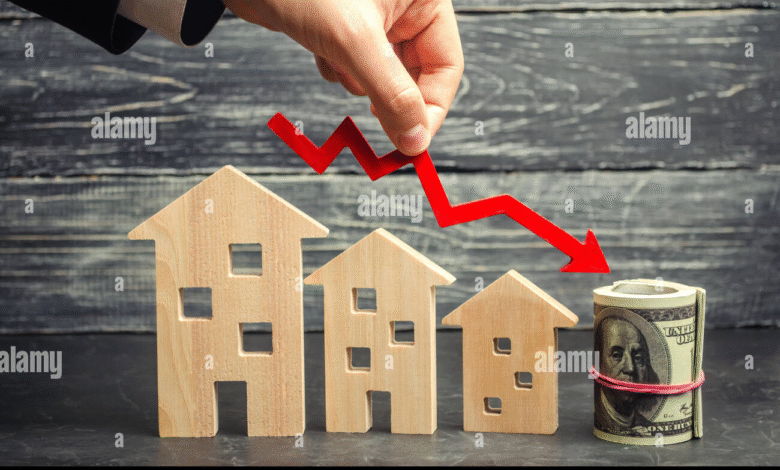Mortgage Demand Decline: Applications Fall Despite Lower Rates

Mortgage demand decline has emerged as a concerning trend in the housing market, marking a dip for the third consecutive week. Despite the average interest rates for home loans slightly decreasing, the total mortgage application volume fell by 3.9% compared to the previous week. This downturn in mortgage applications reveals that potential buyers are still hesitant, as applications for purchasing homes dropped by 4%. Interestingly, even with lower interest rates, refinance activity also declined, showcasing a total drop of 4%. As homeowners wait for more significant rate changes, the overall market dynamics suggest a cautious approach among buyers and refinancers alike.
The recent downturn in mortgage interest seems to connect to a broader stagnation in home-buying enthusiasm. With housing loans becoming less appealing, mortgage inquiries have diminished, even as rates present enticing opportunities for potential homeowners. The decline in loan applications raises questions about the resilience of the housing sector in light of fluctuating economic conditions. Buyers who might benefit from lower refinancing options appear to be holding back, creating a ripple effect in the market. As a result, the housing landscape seems to be caught in a phase of uncertainty, impacting both the purchase and refinancing segments.
Understanding the Mortgage Demand Decline in 2025
Mortgage demand has continued to decline for the third consecutive week, despite a slight decrease in interest rates. The latest mortgage application statistics reveal that applications for home purchases fell by 4% this week. This trend is particularly noteworthy considering that overall applications remain 18% higher than they were this time last year. The intricacies of the current housing market indicate that while interest rates have decreased, borrowers appear hesitant to take the plunge into home ownership, suggesting external economic factors may be influencing buyer confidence.
Furthermore, the overall mortgage application volume has decreased by 3.9% from the previous week, reflecting a more profound trend rather than just a seasonal shift. The decline in mortgage demand is accentuated by a subtle reduction in interest rates, which typically should encourage borrowing and refinancing activities. However, it appears that potential home buyers and borrowers are weighing their options carefully, perhaps anticipating further improvements in economic conditions or awaiting even lower rates before making a purchase.
Impact of Interest Rates on Mortgage Applications
With the average interest rate for 30-year fixed mortgages now at 6.92%, down from 6.98%, it’s evident that even minor fluctuations in these rates can have significant implications for mortgage applications. Lower interest rates generally incentivize potential buyers to enter the housing market; however, this week’s data shows a different reaction. While some applicants may seize the opportunity to secure a lower rate, the overall decline in applications indicates a broader hesitancy in the market.
Additionally, the responsiveness of mortgage applications to changes in interest rates underscores a pivotal moment in the housing sector. Although refinancing activity saw a 4% drop, this figure still reflects a 42% increase compared to last year—a clear indication that while current rates may not be attracting new applicants, they are still appealing to those looking to refinance existing loans. Homeowners are likely weighing their decisions on refinancing against potential future rate drops, illustrating the complex interplay between interest rates and consumer behavior in the mortgage sector.
Analyzing Refinancing Trends amid Changing Mortgage Rates
Refinancing activity in the mortgage market has taken a hit, with applications dropping by 4% this week. One potential reason for this decline could be attributed to the rising average loan size, which has reached the smallest level since July 2024. As borrowers anticipate more favorable rates in the future, many are choosing to wait rather than refinance now. With the significant difference in borrowing costs compared to last year, many homeowners are still inclined to monitor market conditions closely before making decisions.
Moreover, the appetite for refinancing has increased in the past year, with a 42% year-on-year rise noted in application volumes. Yet, even with lower interest rates, many homeowners may be conditioned to expect more favorable outcomes. As the market awaits potential economic shifts, borrowers seem to prefer a wait-and-see approach, fostering uncertainty in refinancing activity. This hesitation highlights the influence of market psychology, where expected future rate trends play a crucial role in making timely refinancing decisions.
Current Housing Market Dynamics and Their Effects
The current state of the housing market is complex, particularly as it relates to the observed decline in mortgage applications and the economic environment. The key driver of increased purchase demand has been attributed to a greater availability of homes, which has reached a five-year high. Nevertheless, the sluggish pace of closed sales indicates that merely having more options available does not guarantee increased transaction activity. Factors such as economic uncertainty and fluctuating interest rates are keeping prospective buyers on the sidelines.
Despite this, the overall context shows that applications for purchasing homes are still 18% higher compared to the same week last year. This suggests a foundational strength in the market, as buyers are beginning to navigate the landscape. However, closed sales lag behind historical averages, indicating that while interest in the market is present, actual commitments to purchase remain tepid. As housing supply stabilizes and buyers become more confident in their decision-making abilities, we may see shifts in the dynamics of both mortgage demand and overall housing market performance.
Future Projections for Mortgage Demand: A Look Ahead
As we move forward, the future of mortgage demand hangs in the balance of fluctuating economic indicators and interest rate expectations. Potential home buyers may be keenly watching upcoming reports, such as employment statistics, as these could significantly sway market conditions. Experts predict that any dramatic shift in employment rates might lead to more robust consumer confidence, encouraging a more aggressive approach to purchasing homes and securing mortgages.
In addition, with the Federal Reserve’s ongoing adjustments to interest rates and its impact on financial conditions, many industry observers believe that the coming months could bring about a renewed interest in home loans. If rates continue on a downward trend, there may be an uptick in mortgage applications, particularly among first-time buyers who have been waiting for favorable market conditions. The interplay between external economic factors and individual buyer readiness will ultimately shape the trajectory of mortgage demand in the latter half of 2025.
The Role of Economic Indicators in Mortgage Demand
Amid declining mortgage demand, economic indicators play a crucial role in shaping buyer behavior and market trends. Key metrics such as employment rates, consumer confidence, and inflation sentiment are intertwined with mortgage applications and housing market conditions. As quality jobs become scarce or inflation pressures mount, potential buyers may feel hesitant to commit to significant financial decisions like purchasing a home, even with lower mortgage rates.
Furthermore, as economic indicators fluctuate, they directly influence mortgage lenders’ willingness to offer favorable terms. If key metrics show signs of stabilization or improvement, it will likely boost market confidence, resulting in a surge of mortgage applications. Conversely, if economic uncertainty lingers, potential borrowers may remain cautious, further contributing to the ongoing decline in mortgage demand. Keeping a close eye on these indicators is essential for understanding the broader implications for the housing market.
Evaluating Buyer Sentiment in the Current Housing Climate
Buyer sentiment is a significant factor currently impacting the housing market and mortgage applications. Surveys indicate that many consumers are feeling apprehensive about entering the market, despite attractive interest rates. The psychological barriers to homebuying—a result of uncertain economic conditions—are causing buyers to proceed with caution, leading to a decline in mortgage demand. This sentiment is further aggravated by fears surrounding potential economic downturns.
Moreover, as the spring selling season progresses slowly, it becomes increasingly evident that buyer sentiment must shift for the housing market to thrive. Various stakeholders, including lenders, realtors, and policymakers, must work to inspire confidence among potential buyers. This could involve educational initiatives about the advantages of homeownership, even in a fluctuating market, which may help alleviate concerns and stimulate demand in the mortgage sector.
Mortgage Strategies for Buyers in a Volatile Market
In these uncertain times, potential homebuyers can benefit significantly from informed mortgage strategies that cater to current market conditions. With interest rates seeing minor declines, buyers should consider locking in favorable terms while they can, particularly when mortgage costs hold long-term implications. Additionally, working closely with mortgage professionals can help buyers navigate their options effectively, from conventional loans to government-backed programs designed for first-time homeowners.
Moreover, prospective buyers should remain proactive in their research and stay informed about market fluctuations. Understanding how changing interest rates impact overall borrowing costs can empower buyers to make the best financial choices. By balancing caution with strategic decision-making, homebuyers can position themselves to take advantage of favorable conditions, ultimately leading to an increased likelihood of securing a mortgage that aligns with their financial goals, even amid a declining demand environment.
Exploring the Relationship Between Interest Rates and Housing Inventory
The dynamics of interest rates and housing inventory are closely linked, influencing both mortgage demand and market activity. Recent decreases in interest rates have, in theory, encouraged more buyers to consider the market. However, the relationship between these rates and available housing inventory plays a critical role in shaping consumer choices. As inventory rises, buyers may feel more confident in entering the housing market, regardless of slight fluctuations in mortgage rates.
Additionally, increased housing inventory suggests a shift towards a more balanced market, potentially alleviating previous seller advantages. Buyers now have more choices, which may drive them to act faster, especially as rates hover around favorable levels. The interplay of these factors can create a unique environment where mortgage demand may fluctuate based on shifts in both interest rates and housing availability—a key aspect for potential borrowers to monitor closely.
Frequently Asked Questions
Why is there a mortgage demand decline despite falling interest rates?
The recent mortgage demand decline, even with falling interest rates, can be attributed to ongoing uncertainty in the housing market and a slight drop in mortgage applications for home purchases. While interest rates for 30-year fixed-rate mortgages have decreased, potential buyers are still hesitant, leading to a 4% drop in applications this week. Many are waiting for more significant rate decreases before entering the market.
How do current interest rates impact mortgage applications?
Current interest rates have a direct impact on mortgage applications. While average rates for 30-year fixed mortgages have decreased to 6.92%, this has not significantly boosted mortgage applications, which have fallen by 3.9% recently. The hesitance of buyers and borrowers to commit amidst a fluctuating housing market is a likely factor.
What trends are observed in home loan refinance activity amid mortgage demand decline?
During this mortgage demand decline, refinance activity has also decreased by 4%, despite being 42% higher than the same period last year. Borrowers are waiting for larger rate reductions to refinance their home loans, which indicates that current interest rates are not compelling enough for many to take action.
How has the housing market influenced mortgage demand declines recently?
The housing market has seen an increase in the availability of homes, but this has not led to stronger mortgage demand. Despite mortgage applications for home purchases being 18% higher compared to last year, the overall activity has slowed, as many buyers are cautious due to economic uncertainties, contributing to the mortgage demand decline.
Are mortgage rates expected to fluctuate in the near future?
Yes, mortgage rates may fluctuate in the near future. Following the slight decline seen this week, market analysts are anticipating potential changes after the release of significant economic reports, which could lead to variations in mortgage demand depending on how these figures impact buyer confidence.
| Key Point | Details |
|---|---|
| Average Contract Interest Rate | The average rate for 30-year fixed mortgages fell to 6.92% from 6.98%. |
| Year-Over-Year Rate Comparison | Current rates are 15 basis points lower than this time last year. |
| Mortgage Applications for Home Purchases | Applications dropped 4% this week but are 18% higher compared to the same week last year. |
| Refinance Activity | Refinance applications fell 4% but are 42% higher than last year. |
| Market Conditions | The spring selling season is slow despite an increase in available homes. |
Summary
Mortgage Demand Decline is evident as mortgage applications dropped for the third week in a row, despite a decrease in interest rates. With the average contract interest rate for 30-year fixed-rate mortgages falling to 6.92%, one might expect a boost in demand, but the reality is different. The application volume has consistently fallen, indicating broader market challenges. While the numbers show a significant year-over-year increase in purchase and refinance applications, the current decline highlights consumer hesitance in the face of ongoing market uncertainty.




